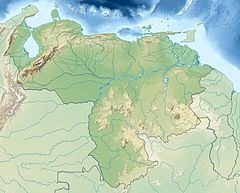Atelopus vogli
| Atelopus vogli | |
|---|---|
| Scientific classification | |
| Domain: | Eukaryota |
| Kingdom: | Animalia |
| Phylum: | Chordata |
| Class: | Amphibia |
| Order: | Anura |
| Family: | Bufonidae |
| Genus: | Atelopus |
| Species: | †A. vogli
|
| Binomial name | |
| †Atelopus vogli Müller, 1934
| |
| Synonyms[2] | |
|
Atelopus cruciger vogli Müller, 1934 | |
Atelopus vogli is an
type locality, Las Peñas near Hacienda la Trinidad in Aragua, and Montalbán in Carabobo.[2][3] It was first described as subspecies of Atelopus cruciger.[2][4] The specific name vogli honours Cornelius Vogl, German priest who was a missionary in Venezuela in 1925–1959. Common name Vogl's harlequin toad has been coined for it.[5]
Description
Adult males measure 21–29 mm (0.83–1.14 in) and adult females 33–39 mm (1.3–1.5 in) in snout–vent length. The snout is pointed in dorsal view. No tympanum is visible, but the supratympanic crest is well developed. There are small rounded warts present on the dorsolateral surfaces, most prominently around the arm insertions and as a dorsolateral row. The fingers have some basal webbing while the toes are slightly more webbed. The hind limbs are relatively long. Preserved specimens have uniform tan color (coloration in life unknown).[4]
Two known former populations of Atelopus vogli on the southern slopes of the Venezuelan Coastal Range.
Habitat and conservation
The type locality was a semi-deciduous humid forest at about 600–700 m (2,000–2,300 ft)
above sea level.[1][4] The Montalbán population lived at similar elevation; both localities are on the southern slopes of the Venezuelan Coastal Range.[3] The species was apparently very abundant at the type locality as in excess of 400 specimens were collected in 1933. The other locality is represented by a single specimen collected in 1957 and found to represent this species in 2009.[3] These are the latest known sightings of this species now believed to be extinct.[1][3] In the case of the type locality, the cause of extirpation was likely total habitat modification caused by human activities.[1]
References
- ^ . Retrieved 14 November 2021.
- ^ a b c Frost, Darrel R. (2017). "Atelopus vogli Müller, 1934". Amphibian Species of the World: an Online Reference. Version 6.0. American Museum of Natural History. Retrieved 26 November 2017.
- ^ a b c d Barrio-Amorós, C. L. & Rojas-Runjaic, F. J. M. (2009). "A new locality for a species considered extinct (Anura: Bufonidae: Atelopus vogli) raises hope for survival". Salamandra. 45 (4): 254–256.
- ^ S2CID 44095407.
- ISBN 978-1-907807-42-8.


